

Designing and Developing Advanced Driver Assistance Systems (ADAS) Tom Wilson Tom Wilson is Vice President of Business Development at CogniVue Corporation, with more than 20 years of experience in various applications such as consumer, automotive, and telecommunications.
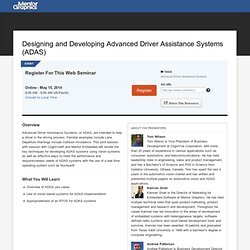
He has held leadership roles in engineering, sales and product management, and has a Bachelor’s of Science and PhD in Science from Carleton University, Ottawa, Canada. Tom has spent the last 4 years in the automotive vision market and has written and presented multiple papers on automotive vision and ADAS applications. Kamran Shah Kamran Shah is the Director of Marketing for Embedded Software at Mentor Graphics. Andrew Patterson Andrew Patterson is Business Development Director for Mentor Graphics embedded division, specializing in the automotive market.
Autonomous car - Wikipedia, the free encyclopedia - Aurora. An autonomous car,[1] also known as a driverless car,[2] driver-free car,[3] self-driving car[4] or robot car,[5] is an autonomous vehicle capable of fulfilling the human transportation capabilities of a traditional car.
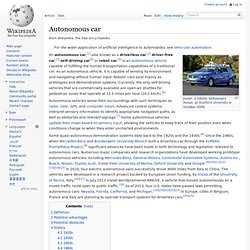
As an autonomous vehicle, it is capable of sensing its environment and navigating without human input. Robotic cars exist mainly as prototypes and demonstration systems. Currently, the only self-driving vehicles that are commercially available are open-air shuttles for pedestrian zones that operate at 12.5 miles per hour (20.1 km/h). Autonomous vehicles sense their surroundings with such techniques as radar, lidar, GPS, and computer vision. Advanced control systems interpret sensory information to identify appropriate navigation paths, as well as obstacles and relevant signage.[7] Some autonomous vehicles update their maps based on sensory input, allowing the vehicles to keep track of their position even when conditions change or when they enter uncharted environments.
California legislature approves laws for self-driving cars. Volvo traffic jam assistance system takes over the chore of stop/start driving - Aurora. Volvo's new traffic jam assistance system autonomously follows the car in front Image Gallery (5 images) There are few things more frustrating than crawling along in stop/start traffic.
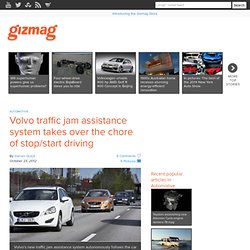
Volvo has now come up with a system designed to make such monotonous trips a little more tolerable. Volvo traffic jam assistance brings self-driving cars one step closer. Google isn’t the only corporation trying to pitch self-driving cars to the average commuter.

Volvo plans to introduce a car that can drive itself through a traffic jam in 2014. What the company calls “traffic jam assistance” will allow a car to automatically follow the vehicle in front at low speeds. Traffic jam assistance is an outgrowth of Volvo’s Adaptive Cruise Control and Lane Keep Aid Technology. Both systems allow a car to act on its own in limited circumstances, but traffic jam assistance will give the machine more control. Like Adaptive Cruise Control, traffic jam assistance maintains a set distance from the car in front. The system, which is activated with the push of a button, might inspire thoughts of Christine, or KITT’s evil twin, KARR. Mercedes-Benz F800 - Wikipedia, the free encyclopedia - Aurora. The Mercedes-Benz F800 Style is a concept car presented by the German brand at the 2009 Geneva Motor Show.
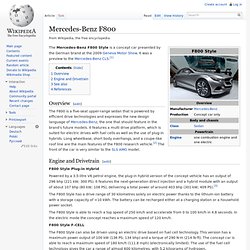
It was a preview to the Mercedes-Benz CLS.[1] Overview[edit] The F800 is a five-seat upper-range sedan that is powered by efficient drive technologies and expresses the new design language of Mercedes-Benz, the one that should feature in the brand's future models. It features a multi drive platform, which is suited for electric drives with fuel cells as well as the use of plug-in hybrids. Long wheelbase, short body overhangs, and a coupe-like roof line are the main features of the F800 research vehicle.[2] The front of the car is very similar to the SLS AMG model. Engine and Drivetrain[edit] Traffic Jam Assistant of the F800 Style. 2012 Family Cars With Self-Parking Technology - Aurora. 2012 Ford Focus Remember back in driver’s ed, or when getting ready for your driving test at the DMV, when parallel parking was a tad tricky?
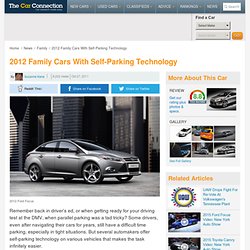
Some drivers, even after navigating their cars for years, still have a difficult time parking, especially in tight situations. But several automakers offer self-parking technology on various vehicles that makes the task infinitely easier. Here we take a look at some of the 2012 family cars with this technology, usually an option or part of a technology package. It’s called by various names such as active park assist, advanced parking guidance, parking assistant and Parktronic. 2012 Ford Escape active park assist Ford and Lincoln: Active Park Assist Available on the 2012 Ford Focus, Escape, Explorer and Flex and on the 2012 Lincoln MKS and MKT, active park assist uses electronic sensors instead of an imaging device. 2012 Lincoln MKS The 2012 Toyota Prius.
Toyota and Lexus: advanced parking guidance 2012 Lexus LS 460 Sport Special Edition. Ford predicts self-driving, traffic-reducing cars by 2017. “Never gonna happen” just got a lot closer.

According to Ford the self-driving car will be here within five years, using technologies available today. The smart car will take over your morning commute on clogged freeways, improving your speed and reducing fuel consumption. Traffic Jam Assist for the masses? In about five years. In the next 12-24 months, luxury vehicles will hit the roads with the driver physically at the wheel, but his mind potentially elsewhere.
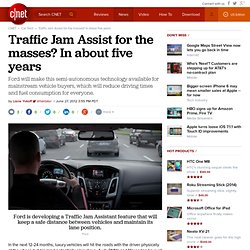
Audi, BMW, and Mercedes have all demonstrated semi-autonomous "traffic jam assistants" that will do the driving in bumper-to-bumper traffic, lessening the stress of the daily commute. But what about for the equally tense driver of your non-luxury vehicle? Luckily, Ford is working to bring that same frill to the mainstream buyer. Ford announced in a news statement that it, too, is developing a semi-autonomous system for its vehicles. The "Traffic Jam Assistant" is an emerging safety feature that will enable the vehicle to keep a safe distance between it and the vehicle in front, while maintaining lane position, without requiring the constant braking, accelerating, and attention from the driver. The company estimates that only 25 percent of vehicles will need to be equipped with some form of traffic jam assistant to reduce travel times by 37.5 percent.
BMW Debuts New Parking Assistant In 2011 5-Series - Aurora. 2011 BMW 535i (Euro spec) The parking-tech wars are escalating, as another new model can be equipped to almost park itself.
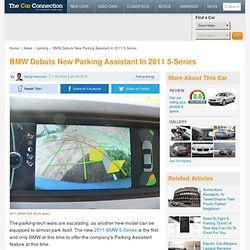
The new 2011 BMW 5-Series is the first and only BMW at this time to offer the company's Parking Assistant feature at this time. BMW Traffic Jam Assistant puts self-driving car closer than you think - Yahoo Autos - Aurora. All the buzz surrounding autonomous, or self-driving cars usually includes a caveat that this technology is at least 10 years away from being ready for prime time, even though Audi, Google, and Lexus have already been racking up miles and showing such vehicles at media events.
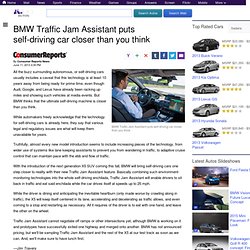
But BMW thinks that the ultimate self-driving machine is closer than you think. While automakers freely acknowledge that the technology for self-driving cars is already here, they say that various legal and regulatory issues are what will keep them unavailable for years. Truthfully, almost every new model introduction seems to include increasing pieces of the technology, from wider use of systems like lane keeping assistants to prevent you from wandering in traffic, to adaptive cruise control that can maintain pace with the ebb and flow of traffic. —Jim Travers More from Consumer Reports:2013 New Car PreviewBest and worst used carsComplete Ratings for 200 cars and trucks TransportationAutosBMW. X5 : Traffic jam assistant - Aurora.